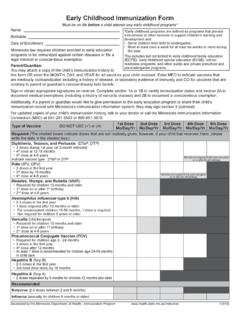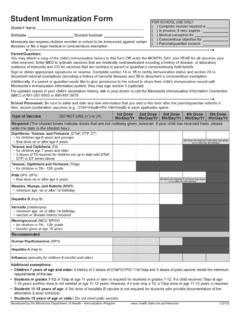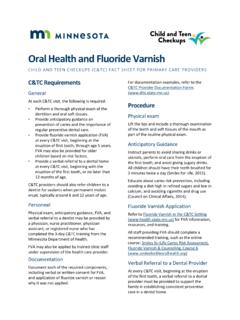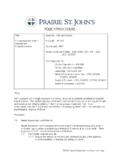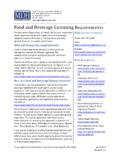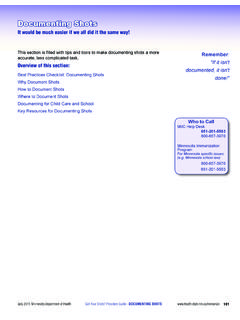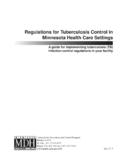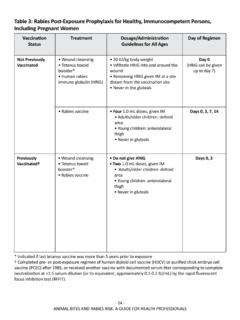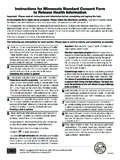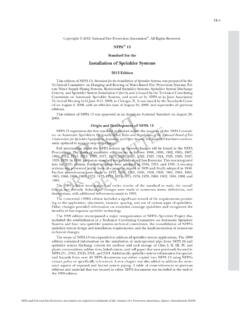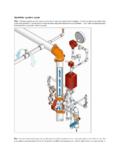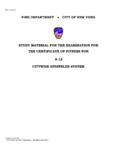Transcription of INSPECTION AND TESTING OF FIRE SPRINKLER SYSTEMS
1 MAINTENANCE AND TESTING OF FIRE SPRINKLER SYSTEMS . Introduction When properly installed and maintained, automatic fire SPRINKLER SYSTEMS have proven to be the most effective means for protecting life and property against fire. In recognition of their excellent track record in controlling the spread of fire, both state codes and national standards offer fire sprinklers as a cost-effective alternative to meeting many of their base code requirements. A lot is riding, therefore, on a SPRINKLER system 's ability to operate and function properly. So much so, in fact, that state law prohibits the occupancy of any portion of a building until the required suppression system has been tested and approved [see MSFC(15), Sec.]
2 ]. Further, MSFC(15), Sec. requires that such SYSTEMS be maintained in an operative condition at all times and be repaired or replaced when defective. In order to meet both federal certification requirements and state licensure requirements, automatic fire SPRINKLER SYSTEMS are required to be inspected, tested and maintained in accordance with NFPA 25, Standard for the INSPECTION , TESTING , and Maintenance of Water-Based Fire Protection SYSTEMS . For federal certification, NFPA. 101(12), Sec. references the 2011 edition of NFPA 25. For state licensure, MSFC(15), Sec. , as amended, and Table also reference the 2011 edition of the standard (see Chapter 80, Referenced Standards).
3 Application: It must be noted that this document is intended to serve as a quick-reference guide only and is not intended to be exhaustive. It covers most, but not all, of the INSPECTION , TESTING and maintenance requirements applicable to fire SPRINKLER SYSTEMS . Some facilities may have additional equipment not covered in this guide. It is important, therefore, that the user have access to, and become familiar with all the requirements found in, NFPA 25. The standard can be ordered from NFPA at 1-800-344-3555 or NFPA Catalog ( ). Note: For new installations, NFPA 13(10), Sec. (2) requires the installing contractor to provide a copy of NFPA 25 for the property owner.
4 system types The requirements contained in NFPA 25 are based on the type of SPRINKLER system installed. The two types most commonly found in healthcare occupancies are wet pipe and dry pipe SPRINKLER SYSTEMS . Some buildings contain both types of SYSTEMS a wet pipe system in heated areas and a dry-pipe system in unheated areas ( exterior canopies). Simply put, a wet pipe SPRINKLER system is a piping system containing water so arranged that water discharges immediately from sprinklers activated by heat from a fire. A dry pipe SPRINKLER system is a piping system containing air or nitrogen under pressure so arranged that upon activation of a SPRINKLER the air or nitrogen is released allowing the water pressure to open a valve and water to then flow into the pipe and out the opened SPRINKLER .
5 Definitions In order to follow the requirements of the standard, it's important to have a good understanding of what is meant by INSPECTION , TESTING and maintenance : Those terms are defined in 1-5 as follows: INSPECTION is defined as, A visual examination of a system or portion thereof to verify that it appears to be in operating condition and is free of physical damage. see NFPA 25(11), Sec. TESTING is defined as, A procedure used to determine the operational status of a component or system as intended by conducting periodic physical checks, such as waterflow tests, fire pump tests, alarm tests, and trip tests of dry-pipe valves.
6 See NFPA 25(11), Sec. July, 2016; Rev: Oct, 2016. Maintenance is defined as, In water-based fire protection SYSTEMS , work performed to keep equipment operable or to make repairs. see NFPA 25(11), Sec. Personnel qualifications NFPA 25 makes the owner responsible for properly maintaining the building fire SPRINKLER system . It is the facility's responsibility, therefore, to ensure that only properly trained and competent persons perform inspections, TESTING and maintenance on its system . NFPA 25 simply states that these tasks, shall be performed by personnel who have developed competence through training and experience. [see NFPA 25(11), Sec.]
7 ]. The State of Minnesota, however, has more restrictive requirements that apply to persons who perform work on fire SPRINKLER SYSTEMS . Such persons must meet certain license and certification requirements [see MN. Statutes, Chapter 299M and MN Rules, Chapter 7512]. What this means is that, unless they meet these requirements, facility personnel are limited to performing INSPECTION and some basic TESTING activities only. The amount of TESTING that can be performed will depend on the level of training received. One of the best sources for such training would be the fire SPRINKLER company that performs the facility's annual service.
8 Evidence of any training received will need to be maintained in each employee's personnel file. system history A number of requirements applied to a health care facility's fire protection SYSTEMS are based on the age and date of installation of those SYSTEMS . Without an accurate written history of the fire protection system (s) in your facility, it can be difficult to prove to a state or federal life safety surveyor that those SYSTEMS are being maintained in accordance with applicable state and federal standards. This can result in fire/life safety deficiencies being cited. Turnover of administrative and/or maintenance personnel only serves to compound the problem.
9 One of the best ways to deal with this is to create and maintain an historical log on your system (s). As with just about anything, the hardest part of creating an historical log is getting started after that, it is a matter of keeping it up-to-date. You should find the fire SPRINKLER contractor that provides your annual service to be an excellent source of information about your system . Basic questions that need to be answered include: When was the system initially installed? Who installed it? Were any additions, modifications or repairs made to the system ? When? Who did the work? It is important to note that certain changes made to your building could necessitate modifications to your fire protection system .
10 Things to watch for include: construction or removal of walls and installation of such things as drop-in ceilings, new suspended light fixtures, tracks for lift SYSTEMS and new cubicle curtains. Where to find the specific requirements . 1. Specific requirements relating to the INSPECTION , TESTING and maintenance of wet- and dry-pipe fire SPRINKLER SYSTEMS can be found in Chapters 5, 13, 14 and 15 of NFPA 25. 2. Specific requirements relating to the INSPECTION , TESTING and maintenance of fire pumps can be found in Chapter 8 of NFPA 25. Specific Requirements The INSPECTION , TESTING and maintenance requirements that apply to your building's fire SPRINKLER system start from the date of initial installation and continue on at specific intervals throughout the life of the system .

